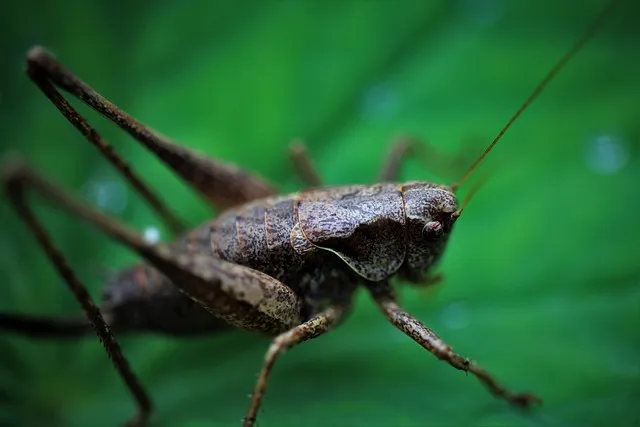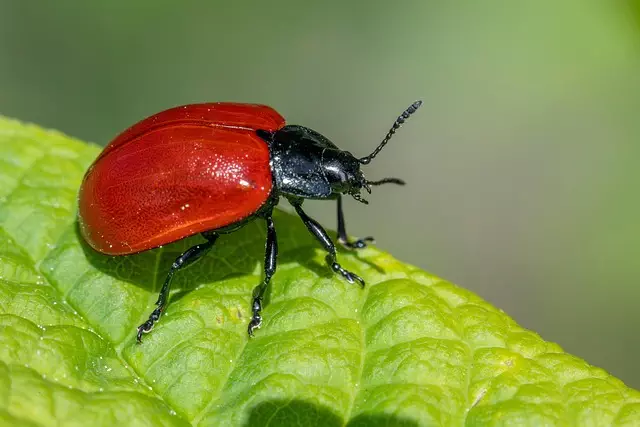Effective insect control services hinge on understanding local populations, climate, and behaviors. By leveraging advanced knowledge, professionals predict insect prevalence, minimize chemical use, and promote environmental health through tailored treatments and preventive measures. This approach is crucial in urban areas facing unique challenges from resilient pests like cockroaches, ants, and termites. Eco-friendly insect control services, such as Integrated Pest Management (IPM), use natural predators, plant repellents, and good hygiene to create pest-unfriendly environments. Seasonal variations necessitate adaptable strategies, with spring/summer focusing on prevention and rapid response, while autumn/winter target indoor pests. Early detection through specialized tools and knowledge enables precise, minimal treatment application. Proactive preventive measures, community education, and collaboration significantly bolster insect control services' effectiveness. Case studies demonstrate successful IPM approaches in urban areas and organic methods in agriculture, highlighting the value of environmentally conscious insect control services.
Local insect control is a multifaceted approach essential for maintaining healthy environments. Understanding your region’s unique insect populations is key to effective management. This article explores various aspects of local insect control, from recognizing common urban pests and their challenges to eco-friendly methods and seasonal adjustments. Discover the benefits of professional services, learn about targeted treatments, preventive measures, community collaboration, and real-world case studies, all vital for successful insect control.
Understanding Local Insect Populations: A Key to Effective Control

Understanding local insect populations is a crucial step in effective insect control services. Different insects thrive in specific climates and environments, and their behaviors and life cycles vary greatly. By studying these factors, pest control professionals can predict where and when certain insects will be most prevalent. This knowledge allows for more precise and targeted treatments, minimizing the use of chemicals and enhancing overall environmental health.
For instance, knowing that a particular species of ant is drawn to moist, secluded areas helps specialists focus their efforts on sealing entry points and applying appropriate insecticides in these specific zones. Similarly, understanding the migration patterns of birds can guide the placement of bird deterrents, reducing the need for chemical interventions. This localized approach not only ensures more effective insect control services but also promotes a balanced ecosystem.
Benefits of Professional Insect Control Services

Professional insect control services offer a multitude of benefits that cater to both residential and commercial properties. One of the primary advantages is their expertise in identifying specific insect infestations and employing targeted treatments. These professionals are equipped with advanced knowledge and tools, ensuring effective elimination of insects like ants, termites, mosquitoes, and rodents without causing harm to people or pets.
Additionally, professional services provide long-term solutions by implementing preventive measures tailored to each property’s unique needs. Regular inspections and maintenance plans help detect potential issues early, preventing costly repairs and ensuring a pest-free environment. With their comprehensive approach, these services enhance the overall quality of life, promoting a healthy and safe living or working space.
Common Pests and Their Unique Challenges in Urban Environments

In urban environments, a variety of insects pose unique challenges for local insect control services. Common pests like cockroaches, ants, and termites thrive in densely populated areas, taking advantage of food sources and shelter provided by buildings and infrastructure. These creatures are adept at hiding in narrow spaces, making traditional pest control methods more complicated. For instance, cockroaches can infiltrate through tiny crevices, while ants form complex networks that make complete eradication difficult.
Another concern is the increased resistance to pesticides among urban pests due to prolonged exposure. Many insects have developed adaptations that render common insect control chemicals less effective. This necessitates the use of specialized treatments and integrated pest management strategies by professional insect control services. These professionals employ targeted methods, such as baiting systems and localized applications, to mitigate pest populations while minimizing environmental impact and ensuring long-term solutions for urban residents.
Eco-Friendly Methods for Local Insect Management

In today’s world, many homeowners and businesses are turning to eco-friendly methods for local insect management as a sustainable alternative to traditional pest control. These strategies focus on minimizing environmental impact while effectively managing insect populations. One popular approach is integrated pest management (IPM), which involves a combination of biological, cultural, and chemical controls. By promoting natural predators like ladybugs and spiders, using plant-based repellents, and practicing good hygiene, IPM aims to create an unbalanced environment that discourages pests.
Eco-friendly insect control services also utilize organic pesticides made from natural ingredients like neem oil, soap, or essential oils. These substances are less toxic to humans and pets compared to synthetic chemicals, yet they remain effective against various insects. Additionally, some companies offer specialized treatments tailored to specific pests, such as ants, termites, or mosquitos, ensuring precise and targeted control without harming non-target organisms.
The Role of Seasonal Changes in Pest Control Strategies

Seasonal changes play a pivotal role in shaping pest control strategies for local insect control services. As temperatures fluctuate and days grow longer or shorter, various insects become more active or less so, dictating tailored approaches to management. For instance, during spring and summer, when many pests like mosquitoes, ants, and certain types of bees reach their peak populations, focused efforts on prevention and rapid response are crucial. This includes regular inspections, sealing entry points, and implementing targeted treatments to disrupt breeding cycles and prevent infestations.
In contrast, autumn and winter present unique challenges with the decrease in insect activity. Some pests may seek shelter indoors, necessitating a different set of strategies such as identifying and sealing potential wintering sites. Seasonal changes also influence the types of insects that become problematic; for example, certain species of spiders and cockroaches might be more prevalent during colder months. Local insect control services must adapt their methods accordingly, leveraging seasonal insights to offer effective, efficient, and eco-friendly solutions tailored to the specific needs of each season.
Targeted Treatment: Identifying Infestations Early and Effectively

Early detection is key when it comes to effective insect control. Professional services are equipped to identify even subtle signs of an infestation, ensuring a swift response. By understanding the unique behaviors and indicators specific insects exhibit, these experts can pinpoint the extent and source of the issue. This targeted approach allows for precise application of treatments, minimizing environmental impact and saving costs in the long run.
Effective insect control services employ various methods to target and eliminate pests. From visual inspections to advanced surveillance techniques, they leave no stone unturned. By quickly addressing infestations, these professionals not only protect homes and businesses but also prevent the spread of diseases and damage to structures. Early intervention is a powerful tool in the battle against insects, ensuring peace of mind for property owners.
Preventive Measures to Secure Your Space Against Insects

Securing your space against insects is a proactive approach that involves implementing preventive measures to deter and minimize infestations. One effective strategy is maintaining a clean environment, eliminating potential food sources and water accessories, especially in areas frequented by humans. Regularly cleaning outdoor spaces, ensuring proper garbage disposal, and repairing leaky pipes or fixtures can significantly reduce insect attraction.
Another crucial aspect is sealing entry points such as cracks, gaps in doors, or windows. Insects are tiny and can squeeze through the smallest openings; thus, using caulk or weatherstripping to seal these areas prevents their entry. Additionally, installing screens on windows and doors not only allows fresh air circulation but also acts as a physical barrier against flying insects. Employing these preventive measures alongside professional insect control services creates an impenetrable defense, ensuring a bug-free haven.
Community Education and Collaboration for Successful Insect Control

In the pursuit of effective local insect control, community education and collaboration stand as cornerstone strategies. Empowering residents with knowledge about common pests and their behaviors fosters a collective effort to prevent infestations. Understanding the importance of timely action and proper waste management practices can significantly reduce pest populations. Insect control services often benefit from this partnership, as informed communities are better equipped to identify and address issues promptly.
Collaboration between local authorities, pest control professionals, and residents leads to more successful long-term solutions. By sharing resources and best practices, everyone involved contributes to creating an environment that discourages pest proliferation. This collaborative approach not only enhances the effectiveness of insect control services but also ensures a more sustainable and eco-friendly management strategy for the community.
Case Studies: Real-World Success Stories in Local Insect Control

In the realm of local insect control, case studies offer tangible proof of successful strategies and their impact. These real-world examples demonstrate how tailored approaches can mitigate pest issues effectively while minimizing environmental impact. For instance, a study in urban areas revealed that combining biological controls, such as introducing natural predators, with targeted chemical interventions led to significant reduction in insect populations, notably in the case of common urban pests like cockroaches and ants. This integrated pest management (IPM) approach not only proves successful but also promotes sustainability by reducing reliance on harsh chemicals.
Another compelling case involves agricultural settings where organic insect control methods were implemented. Farmers adopted strategies such as crop rotation, beneficial insects introduction, and precise application of natural repellents. These practices resulted in improved crop health and yield while ensuring the well-being of local ecosystems. These success stories underscore the efficacy and desirability of insect control services that prioritize environmentally conscious solutions, providing valuable insights for both residential and commercial settings seeking effective yet sustainable pest management.
